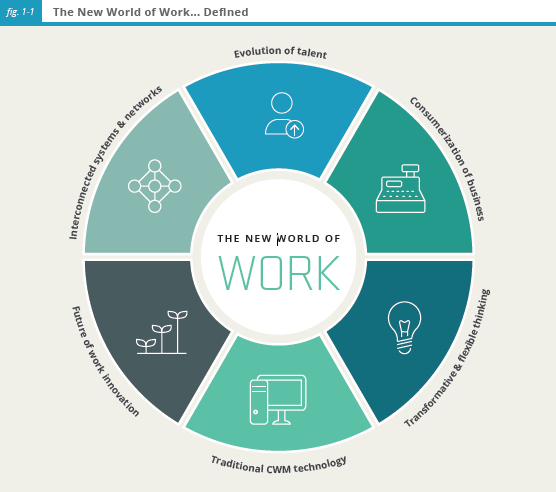
This whitepaper was written by Christopher Dwyer, Vice President of Research at Ardent Partners.
Introduction
The world of work is changing. Transformational thinking is happening within today’s enterprises as the Future of Work, Gig Economy, and other market shifts are occurring. One of the most notable shifts in business today is the rise in non-employee labor, which, according to new Ardent Partners research, comprises approximately 40% of the average business’ overall workforce. However, even with this steady rise in growth and utilization of contingent talent, one major question remains: Is this an effective means of bringing high-quality skillsets into the organization? This Ardent Partners report will deep-dive into the growth of today’s non-employee talent and present research and insights into how a contingent workforce is a critical asset to leverage.
A New World of Talent
For the past decade, the world of work has been changing due to the continued growth of the non-employee workforce. At the time of the Great Recession (2007 – 2008), roughly 15% of the average company’s overall workforce was considered “contingent” in some way. As the global marketplace underwent a sluggish economic recovery period, non-employee talent became the primary means for handling increased demand for products and services, as well as addressing core skills gaps left behind by Recession-era layoffs. Today, 40% of the typical enterprise’s total workforce is considered “non-employee,” and Ardent Partners expects this number, which includes workers sourced via staffing suppliers, professional services, freelancers, independent contractors, outsourced workers, and robotics to continue to rise well into the next decade. This rampant growth, compounded by the increasing strategic importance of multiple facets of the “new world of work,” proves that the non-employee works sits in a critical role today.
Two slices of the “new world of work” graphic above represent just how far talent engagement has come in recent years:
The “consumerization” of business has pushed the boundaries of how companies consume talent, much in the same manner that automation and mobility have revolutionized the consumer’s world into an on-demand shopping arena that is always open and available.
The very evolution of talent, in which companies have steadily increased their year-over-year utilization of non-employee labor to support, augment, and lead both tactical and strategic attributes of the greater organization.
Common Contingent Labor Misconceptions
Although the world around the modern contingent workforce has been transformed significantly over the past several years, there are still many misconceptions regarding the quality, utilization, approach, and overall impact of this segment of the labor market, including:
- Contingent labor is merely viewed as a stopgap for short-term roles that require simple skillsets.
- The vast majority of temporary and external labor should be sourced via staffing suppliers and vendors and other more traditional methods.
- The quality and impact of the contingent workforce is not as significant as the traditional workforce (i.e. FTEs).
- Contingent labor is not a strategic asset to the contemporary enterprise.
While the above aspects, at one time, could be applied to the non-employee workforce, the truth is that these are outdated concepts and are no longer applicable to the contingent workforce of today… considering the advances made in not only talent engagement technology, but also the greater, strategic impact that external workers bring to the modern organization.
The On-Demand Workforce: Agility, Depth, and Quality
For years, the contingent workforce represented no more than a strategy to augment on-hand resources, project-based needs, or seasonal demand. Today’s non-employee workforce, however, contributes much more than tactical skillsets for short-term projects or initiatives. In fact, Ardent’s research has discovered that 97% of organizations today perceive non-employee talent as a
critical, strategic driver of value. With 40% of today’s total workforce considered non-employee, now, more than ever before, contingent labor is a crucial component of the modern enterprise and how it performs in the global marketplace.
A major driver for the growth of the contingent workforce can be attributed to the evolution of talent engagement and the realm of on-demand and online talent platforms. Some of the biggest areas of innovation in today’s world of work, online staffing and online talent platforms, as well as online talent marketplaces and labor automation technology, have enabled businesses (and, more importantly, hiring managers) with the ability to find, engage, and source independent contractors, temporary workers, and freelancers in near real-time.
The online staffing arena has revolutionized how businesses approach their talent gaps. While the usage of major staffing suppliers will never fully cease (since many large-scale organizations leverage these vendors for high-volume staffing and have developed long-term relationships with key staffing stakeholders that understand the nuances of a company’s hiring needs), the fact is that the utilization of online staffing is on the rise. In 2018, Ardent Partners finds that nearly 60% of all organizations across the globe are currently augmenting their traditional talent acquisition strategies with online and digital staffing outlets, proving that these on-demand talent marketplaces have become (and will continue to be) robust sources of skillsets.
The Algorithm Factor: Ensuring Quality
One of the hesitations with using online staffing outlets is the fear that workers or freelancers engaged via these platforms will not be of the same quality as talent sourced through more traditional means (i.e. staffing suppliers). However, many online talent platforms are built on innovative, data-led functionalities that help users “match” a specific project’s key requirements (as
well as the necessary education, skillsets, certifications, etc.) with the available freelancers/workers. This match factor (often presented in percentage form) can help hiring managers understand the alignment between the work that needs to be done, and the potential workers that can address it. Algorithms and artificial intelligence are quickly revolutionizing the way enterprises engage external talent; by harnessing the power of data and skillset-induced insights, quality of the worker and the project fit may even improve when leveraging online staffing platforms.
The Real Value of the Non-Employee Workforce
While the value and impact of today’s non-employee workforce is not universally understood, the fact remains that the contingent workforce, in 2018, is a real and strategic asset to the modern
enterprise. With 40% of the global workforce considered non-employee, it is clear that more and more organizations are cognizant of the value that contingent labor can bring to various projects, corporate initiatives, and everyday operations. Looking deeper, today’s non-employee workforce is:
- Directly linked to the notion of business agility. The top goal for the average enterprise is to become a truly agile business. Ardent’s research has found that the desire for agility trumps that of decreasing costs, improving compliance, and enhancing visibility (71% of all enterprises cite the desire for agility to be its top business pressure). Agility allows an enterprise to
respond to real-time business challenges in a dynamic manner, and “agile talent” that can be engaged on the organization’s terms (where, when, how long, etc.) will continue to be a factor in just how quickly and effectively a business can address new problems or pivot in a new direction. - Comprised of top-tier, high-quality skillsets. One of the many “side effects” of the Gig Economy is that now, more than ever, talented individuals are adopting a flexible work environment and eschewing traditional full-time positions. Frequently, these independent professionals hold valuable and unique skillsets that are highly in-demand. With the desire to be a part of the Gig Economy, freelancers and independent contractors are leveraging their own expertise and experience to work how, when, and where they want. This creates an opportunity for the
average company to tap into a new type of highly capable workforce. As this workforce is engaged and properly (and effectively) addressing facets of work, true value is the achieved result. - More accessible than ever before due to new engagement platforms. Online talent platforms have hit their highest adoption rate in their brief history, with nearly 60%of organizations across the globe currently leveraging these solutions to find, engage, and source top-tier and high-quality workers. In just a handful of minutes, the contemporary hiring manager (or other business executive) can search and engage available talent that may align to a specific project or initiative, as well as manage tactical operational aspects (such as compliance, payment, etc.). Online and digital staffing is a key element in the new world of work, especially considering both the accessibility they provide to new talent, and the value they bring in helping to facilitate key operational aspects of contingent workforce management, such as compliance and risk management (for example, many digital staffing outlets will indemnify enterprises and ensure that all workers sourced via the platform are compliant with specific industry regulations and certifications).
Conclusion
The future of work includes various strategies, approaches, and new technologies that shape and innovate how work is addressed and done. This is comprised of various attributes, from AI and machine learning to diversity/inclusion and the push for “soft” skills. Non-employee talent sits directly in the center of the future of work concept; the evolution of talent and the consumerization of business both play directly into the progression of work optimization. As enterprises seek to become more competitive and successful in the months and years ahead,
non-employee talent will continue to be a valued asset in addressing dynamic business needs.
And, as the modern enterprise continues to drive towards new and innovative methods of addressing work, the contingent workforce will play a critical role… one that consistently enables business agility and drives enterprise value.
About Ardent Partners
Ardent Partners is a Boston-based research and advisory firm focused on defining and advancing the supply management strategies, processes, and technologies that drive business value and accelerate organizational transformation within the enterprise. Ardent also publishes the CPO Rising and Payables Place websites. It also hosts the prestigious annual CPO Rising Summit. Register for exclusive access to Ardent Partners research and events at ardentpartners.com/newsletter-registration/.




